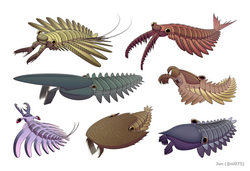| Cucumericrus Temporal range: | |
|---|---|
 | |
| Trunk appengade of Cucumericrus decoratus | |
| Scientific classification | |
| Kingdom: | Animalia |
| Stem group: | Arthropoda |
| Genus: | † Cucumericrus Hou, Bergstrom & Ahlberg, 1995 |
| Type species | |
| Cucumericrus decoratus Hou, Bergstrom & Ahlberg, 1995 | |
Cucumericrus ("cucumber-leg") is an extinct genus of stem-arthropod. The type and only species is Cucumericrus decoratus, with fossils discovered from the Maotianshan Shales of Yunnan, China. [1]
